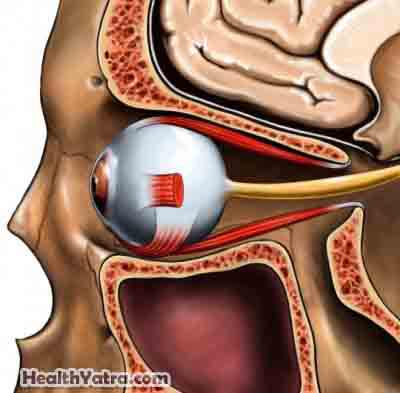Definition
Orbital cellulitis is a serious infection of the bony cavity in which the eyeball sits, which is called the orbit. It is surrounded by sinuses. The sinuses are the hollow areas of the skull around the nose.
Orbital cellulitis affects not only the eye, but the eyelids, eyebrows, and cheeks. It causes the eyeball to have a swollen appearance. If the infection is not treated, it can lead to blindness.

Causes
There are several common causes of orbital cellulitis:
- Infections that spread from areas around the eye including:
- Sinuses—this is the most common reason
- Mouth and teeth
- Face
- Infections that spread from the bloodstream
- Injury or surgery in the area
- Stye on the eyelid
- Bug bite or sting to the eyelid
Children are at high risk of severe infections from orbital cellulitis that could result in blindness. For this reason, they should be given medical attention right away. In young children, the infection is often caused by a sinus infection due to a organism called Haemophilus influenzae.
Risk Factors
Factors that increase your risk of getting orbital cellulitis include:
- Injury to the eyelid
- Sinus infection
- Dental infection
Symptoms
Symptoms of orbital cellulitis include:
- Bulging eye
- Painful eye movements
- Tender or warm tissues around the eye
- Swollen eyelids
- Difficulty seeing when eyelid is swollen
- Fever
- Not feeling well
- Headache
- Runny nose
- Double vision
- Blurry vision
Diagnosis
Doctors can often recognize orbital cellulitis by examining your eyes, teeth, and mouth. Your medical and family history will be taken. You may also have the following tests done:
Your bodily fluids may be tested. This can be done with:
- Blood tests
- Testing samples from the lining of your eye, nose, and throat
- A spinal tap in very sick children
Images may be taken of your bodily structures. This can be done with:
- Computed tomography (CT) scan or MRI
- X-ray of your sinuses and orbit
Treatment
Orbital cellulitis can worsen quickly. Often it requires hospitalization. Treatment for orbital cellulitis includes:
- Antibiotics are given to treat the infection. They will be started right away, even before results from the laboratory have come back. Antibiotics are generally given by mouth for three weeks. If the infection is serious, antibiotics may be given through an IV for at least several days.
- Nasal decongestants will help sinus drainage if you have sinusitis.
- Diuretics or eye drops are given to help decrease pressure within the eyeball.
- Surgery may be performed to drain a pus collection from an infected sinus or orbit.
If you are diagnosed with orbital cellulitis, follow your doctor’s instructions .
Prevention
Treating sinus or dental infections right away may prevent them from spreading to the eyes. In addition, children should be protected with the Hib B vaccine, which will prevent most of the Haemophilus influenzae infections.
